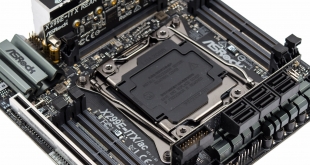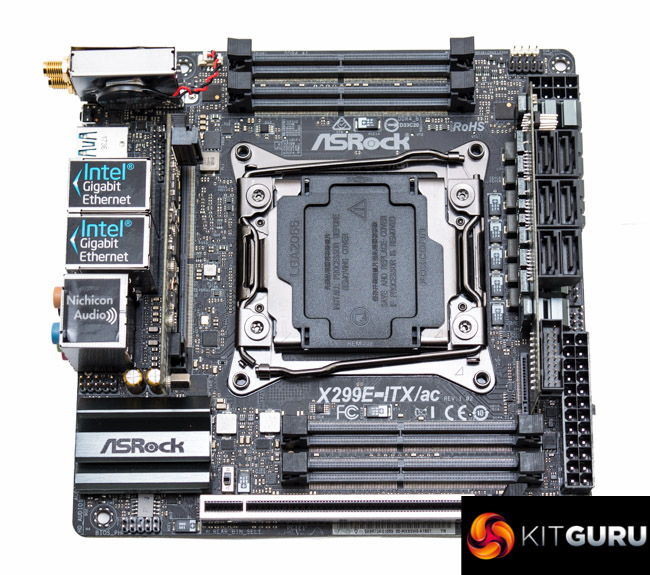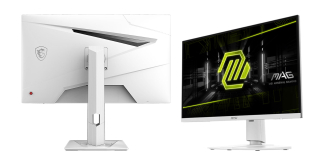
ASRock has a reputation for delivering mini-ITX motherboards for Intel's high-end desktop (HEDT) platform where other motherboard vendors dare not try. With X299 ASRock has done it again, this time with the X299E-ITX/ac, and this small-yet-mighty motherboard has a range of tricks up its sleeves.

Mini-ITX motherboards for a platform like X299, where the LGA2066 socket is so large, inevitably involves compromise even for the highly-skilled engineers that previously developed the ASRock X99E-ITX/ac motherboard. That compromise is by no means a bad thing because it facilitates innovation, experimental thinking and new approaches to the space constraints of the mini-ITX form factor.
ASRock's innovation for its X299 mini-ITX motherboard is particularly fascinating – full quad channel memory support by opting for DDR4 SO-DIMM (laptop memory) rather than DDR4 DIMM (desktop memory). The X99 iteration of ASRock's mini-ITX motherboard opted for two DDR4 DIMM slots as its memory solution which sacrificed the benefits of quad channel memory but retained the familiar DDR4 DIMM form factor.
ASRock has made plentiful use of “daughterboards”, secondary vertical PCBs, that have long been used by motherboard vendors on mini-ITX motherboards as a space-saving tactic since at least the introduction of the Z77 chipset in 2012. The ASUS P8Z77I-Deluxe is the first such mini-ITX motherboard that comes to mind that used a daughterboard in a mini-ITX form factor.
ASRock, though, has opted to use the daughterboards for connectivity like SATA and M.2 rather than the VRM solution, as has been typical in the past. As such ASRock is still able to offer triple M.2, six SATA ports, quad channel memory, dual Gigabit, Wi-Fi, USB 3.1 and more, all in a tidy mini-ITX form factor.
| ASRock X299E-ITX/ac |
|
| Form Factor | mini-ITX, 17 x 17 cm |
| CPU Socket | LGA 2066, 7 phase VRM |
| Chipset | Intel X299 |
| Memory | DDR4, 4 SO-DIMMs, up to 64GB, up to 4000MHz+ with OC |
| Onboard Graphics | None |
| Discrete Graphics | Single Graphics Card configurations only |
| Expansion Slots | 1 x PCIe 3.0 X16 (16X from CPU) |
| Storage | 6 x SATA III (all via X299) 3 x M.2 32Gbps (2 support PCIe mode only, 1 supports SATA III mode and PCIe) |
| USB | 2 x USB 3.1 (1 Type-A and 1 Type-C, 2 Rear, all via ASM3142) 6 x USB 3.0 (4 Rear via ASM1074, 2 Front via X299) 2 x USB 2.0 (2 Front via X299) |
| Networking | 1 x Intel I219V Gigabit Ethernet 1 x Intel I211AT Gigabit Ethernet Intel 8265NGW 2T2R 802.11ac Wi-Fi MU-MIMO with Bluetooth 4.2 |
| Audio | Realtek ALC1220 7.1 Channel HD Audio |
| Fan Headers | 3, all support 3/4 pin fans, (1 x CPU 12W/1A, 1 x CPU_OPT/W_PUMP 15W/1.5A, 1 x SYS) |
| Rear I/O | 2 x Antenna Ports 1 x Optical SPDIF Out Port 1 x USB 3.1 Type-A Port (10 Gb/s) (ASMedia ASM3142) 1 x USB 3.1 Type-C Port (10 Gb/s) (ASMedia ASM3142) *4 x USB 3.0 Ports (ASMedia ASM1074 Hub) *2 x RJ-45 LAN Ports with LED (ACT/LINK LED and SPEED LED) 1 x Clear CMOS Button / Power Button HD Audio Jacks: Rear Speaker / Central / Bass / Line in / Front Speaker / Microphone (Gold Audio Jacks) *Will not work if X299E-ITX REAR card is removed |
| UEFI | 128Mb UEFI AMI |
 KitGuru KitGuru.net – Tech News | Hardware News | Hardware Reviews | IOS | Mobile | Gaming | Graphics Cards
KitGuru KitGuru.net – Tech News | Hardware News | Hardware Reviews | IOS | Mobile | Gaming | Graphics Cards



I like that vertical design, sure we can save some space with designs like that.
I understand that having a lot of daughterboards increase the cost, but I live to see a day when I could be able to build a custom pc like the apple mac g4 cube.